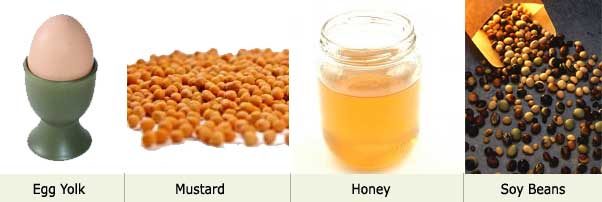Emulsifiers are extremely important components of preserved and processed foods. Chemically, these additives are food mixtures and oils which add extra taste to the processed food. An emulsifying agent is usually important to make a smooth paste. These also prevent water and oil to separate from each other, thus improving the shelf life of processed foods. The emulsifier is one of the most important food additive and it is so important owing to the fact that it helps maintain the integrity of the food and also improves taste.
To emulsify foods, a lot of natural ingredients are often used. Some of the most commonly used foods which contain emulsifiers include chewing gum, mayonnaise, peanut butter, soft drinks, mousses and desserts, bread, caramel, cakes, soft drinks and ice creams.in low fat foods, emulsifiers not only enhance the taste and the quality, but also help prevent growth of mold. Here are some of the most commonly used natural emulsifiers.

Mustard
Mustard seeds, when ground to a paste, can be great emulsifiers. They can add or control the texture of many foods. Both mustard paste and mustard flour can be used to add emulsifying properties to the food. Ground mustard is usually used in meat products, allowing the meat to become soft so that it can be sliced easily. Due to its excellent emulsifying properties, it is commonly used in salads and dips.
Egg Yolk
If you read the labels of foods carefully, you will realize that egg yolk is a commonly used ingredient in many foods. Eggs contain several amino acids, some of which have both water repelling and water binding properties. This helps bind both oil and water to egg yolk, therefore making it an excellent emulsifying agent. Egg yolk is used in pastries, ice creams and many other foods which ordinarily do not have egg as a main ingredient. Egg yolk contains a compound named lecithin, which is an excellent emulsifier for salad dressings. Mayonnaise is also another food in which yolk is an emulsifier. Egg as an emulsifier is most important food additive in salad dressings.
Honey
Though this is not the most used emulsifier, honey has emulsifying properties as well. It is used in many food products as an additive. Honey has bacteria fighting properties and therefore is great for increasing the shelf life of the food product. It helps break up accumulated fats in the foods so that the foods remain fresher for longer. For more savory foods, honey is usually replaced as an emulsifier by maple syrup and corn starch. Honey is paired up with vinegar for making salad dressings. This helps produce a creamier texture and also gives an excellent biting taste to the salad dressing.
Soy Beans
Soy beans have some degree of emulsifying properties due to the small amounts of lecithin found in them. The amount of lecithin in soy beans is only in traces as compared to egg yolk, and therefore egg yolk takes a preference as an emulsifying agent. Soybean, when heated along with water, can be a great way to add a creamy texture to salad dressings. If you are not too keen on using honey, or are watching your weight, soy beans can be very good emulsifier acting as a food additive.
